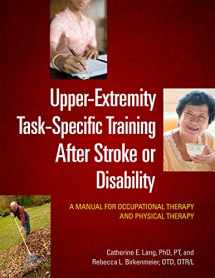
Upper-Extremity Task-Specific Training After Stroke or Disability
Book details
Summary
Description
Task-specific training has emerged as an effective intervention for relearning a motor skill when used by itself or in combination with other interventions. Evidence supports the use of active, repetitive practice of functional activities to restore motor control and gain the capacity to complete important functions for daily life.
Drawing on decades of clinical research and practice, this practical manual describes how to effectively integrate task-specific training into occupational therapy and physical therapy interventions. Included are 100 self-care, productivity, and leisure task examples, each of which describes the key impairments that the task addresses, materials needed to perform the task, ways to make the task more or less difficult, how to determine task mastery, and ideas for related tasks.
Highlights include assessing sensorimotor impairments; matching goals with specific tasks; grading tasks to challenge motor capabilities; selecting complementary tasks; and making adaptations for people with pain, ataxia, apraxia, and hemispatial neglect. This manual promotes client-centered care, encouraging practitioners to match clients' motor capabilities, goals, and interests to specific, challenging tasks. Comprehensive and practical, this work guides allied health practitioners in every aspect of task-specific training.


We would LOVE it if you could help us and other readers by reviewing the book
Book review


